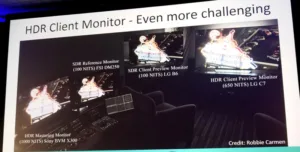Bill Baggelar from Sony Pictures Entertainment began his presentation with the question: Do we need EDR or HDR for cinema? He defined EDR as typical of what IMax or Dolby Cinema can produce today with a clear focus on deep black but with limited highlights. He concluded that EDR was a good first step, but cinemas must keep pace with home entertainment, so HDR will be needed as a minimum.
LED-based cinema solutions are here today (Samsung) and Sony and others will follow. But, there are many problems to solve. He highlighted judder/motion interpolation; a sound solution, scaling of images to fit different resolution and aspect ratio screens, plus the potential to perform tone mapping again to support a variety of screen capabilities.
Tyler Pruitt from Portrait Displays gave an overview of the existing HDR reference grade monitors: Dolby Pulsar (LCD, 4000 cd/m²); Sony BVM-X300 (RGB OLED, 1000 cd/m²) and the Canon DP-V2421 (LCD, 1000 cd/m²). Eizo and Postium have now launched new LCD monitors (dual panel, 1000 cd/m²) and Flanders Scientific and TVLogic have new LCD-based monitors too (dual panel, 2000 cd/m²). The problem is that these reference grade monitors are too expensive (starting at $30K) to help HDR become a more mainstream process with filmmakers. He acknowledged that they can calibrate these displays identically, but they don’t always look the same to trained eyes.
But color grading suites also use “client monitors”, typically large OLED TVs or high performance monitors. Getting a client monitor to look perceptually similar to the reference monitor is now achievable for SDR, but much more challenging for HDR, said Pruitt.
However, both OLED and LCD TVs continue to improve rapidly. Sony has already shown a 10K cd/m² prototype too. Already, episodic TV is often graded on these high-end TVs, so Pruitt wondered if client monitors will be needed in the future? Perhaps the corollary is more relevant: will we need expensive reference monitors if calibrated client monitors can do the trick?
 Eric Pearson from Pixar Animation talked a little about the process of grading in HDR for the home and Extended Dynamic Range (EDR) for the cinema. For mainstream theatrical releases, the SDR grade comes first with the EDR grade done in parallel or very closely thereafter, typically. This is always approved by the creative team. But when creating the HDR grade, the much higher luminance level can change the perception of colors and color saturation. They have had creatives come in after the HDR grade and say, “that is not my movie”, requiring a whole new regrade.
Eric Pearson from Pixar Animation talked a little about the process of grading in HDR for the home and Extended Dynamic Range (EDR) for the cinema. For mainstream theatrical releases, the SDR grade comes first with the EDR grade done in parallel or very closely thereafter, typically. This is always approved by the creative team. But when creating the HDR grade, the much higher luminance level can change the perception of colors and color saturation. They have had creatives come in after the HDR grade and say, “that is not my movie”, requiring a whole new regrade.
He says it is important to see the HDR grade during production, but reference grade monitors are too expensive so artists are working on Rec. 709 monitors – not an ideal solution. The workflow they currently use is to first do a 4000 cd/m² grade on the Dolby Pulsar monitor to create the EDR and SDR cinematic releases. For home release, they do 1000 cd/m² and 600 cd/m² trim passes on the Sony X-300 and Dolby PRM. Approvals are done on a “suoped-up” Christie laser projector. Encoded versions are reviewed on an LG C7 OLED TV. – CC

